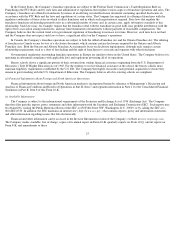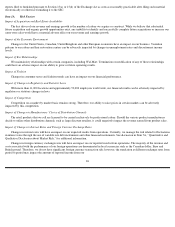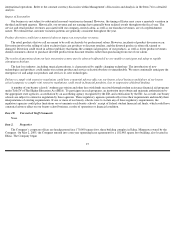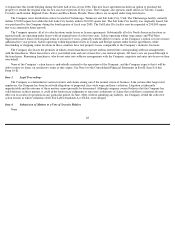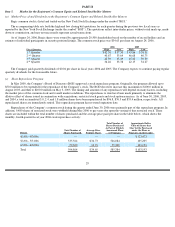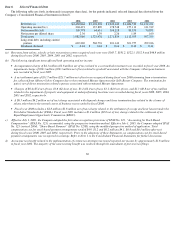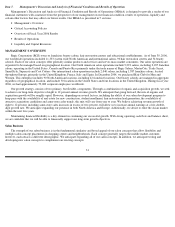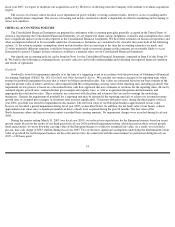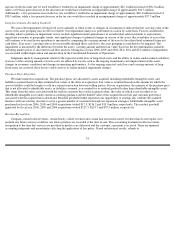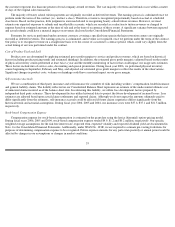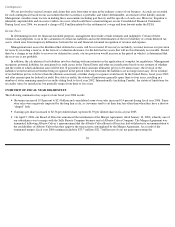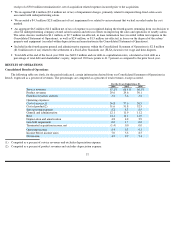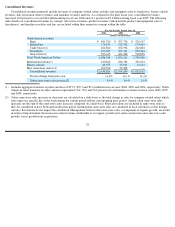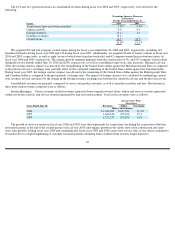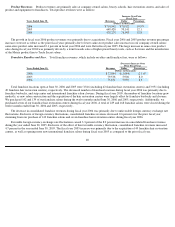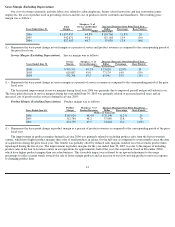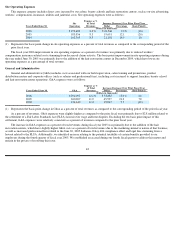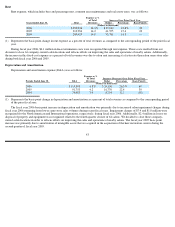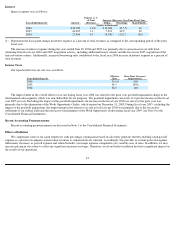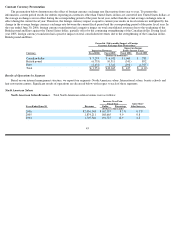Supercuts 2006 Annual Report Download - page 36
Download and view the complete annual report
Please find page 36 of the 2006 Supercuts annual report below. You can navigate through the pages in the report by either clicking on the pages listed below, or by using the keyword search tool below to find specific information within the annual report.
the customer represent less than one percent of total company-owned revenues. The vast majority of returns and refunds occur within a matter
of days of the original sales transaction.
The majority of beauty school tuition payments are originally recorded as deferred revenues. The earnings process is culminated once we
perform under the terms of the contract (i.e., instruct a class). Therefore, revenue is recognized proportionally based on actual or scheduled
class hours. Based on this practice, little judgment is exercised related to recognizing beauty school tuition revenues. However, we must
estimate our expected exposure to refunds and uncollectible accounts, which are recorded as a reduction to tuition revenues or charged to
expense based on estimated amounts at the time of sale and at the time of occurrence of these events. A significant variance between expected
and actual refunds could have a material impact on revenues disclosed in the Consolidated Financial Statements.
Payments for services performed under customer contracts covering a specified time span in the hair restoration centers are originally
recorded as deferred revenues. The earnings process is culminated, and revenue is recognized, once we perform under the terms of the contract.
Our policy is to recognize revenue on a straight-line basis over the course of a customer’s contract period, which could vary slightly from the
actual timing of services performed under the contract.
Cost of Product Used and Sold
Product costs are determined by applying estimated gross profit margins to service and product revenues, which are based on historical
factors including product pricing trends and estimated shrinkage. In addition, the estimated gross profit margin is adjusted based on the results
of physical inventory counts performed at least twice a year and the monthly monitoring of factors that could impact our usage rates estimates.
These factors include mix of service sales, discounting and special promotions. During fiscal year 2006, we performed physical inventory
counts beginning in September, February and May, and adjusted our estimated gross profit margin to reflect the results of the observations.
Significant changes in product costs, volumes or shrinkage could have a material impact on our gross margin.
Self-insurance Accruals
We use a combination of third party insurance and self-insurance for a number of risks including workers’
compensation, health insurance
and general liability claims. The liability reflected on our Consolidated Balance Sheet represents an estimate of the undiscounted ultimate cost
of uninsured claims incurred as of the balance sheet date. In estimating this liability, we utilize loss development factors prepared by
independent third party actuaries. These development factors utilize historical data to project the future development of incurred losses. Loss
estimates are adjusted based upon actual claims settlements and reported claims. Although we do not expect the amounts ultimately paid to
differ significantly from the estimates, self-insurance accruals could be affected if future claims experience differs significantly from the
historical trends and actuarial assumptions. During fiscal year 2006, 2005 and 2004, our insurance costs were $37.6, $37.1 and $31.5 million,
respectively.
Stock-based Compensation Expense
Compensation expense for stock-based compensation is estimated on the grant date using the lattice (binomial) option-pricing model.
During fiscal years 2006, 2005 and 2004, stock-based compensation expense totaled $4.9, $1.2 and $0.2 million, respectively. Our specific
weighted average assumptions for the risk free interest rate, expected term, expected volatility and expected dividend yield are documented in
Note 1 to the Consolidated Financial Statements. Additionally, under SFAS No. 123R, we are required to estimate pre
-vesting forfeitures for
purposes of determining compensation expense to be recognized. Future expense amounts for any particular quarterly or annual period could be
affected by changes in our assumptions or changes in market conditions.
35


